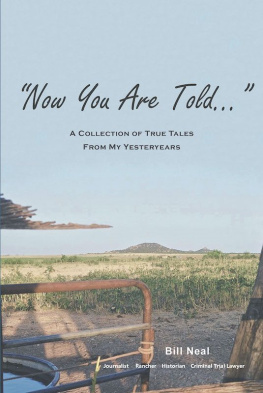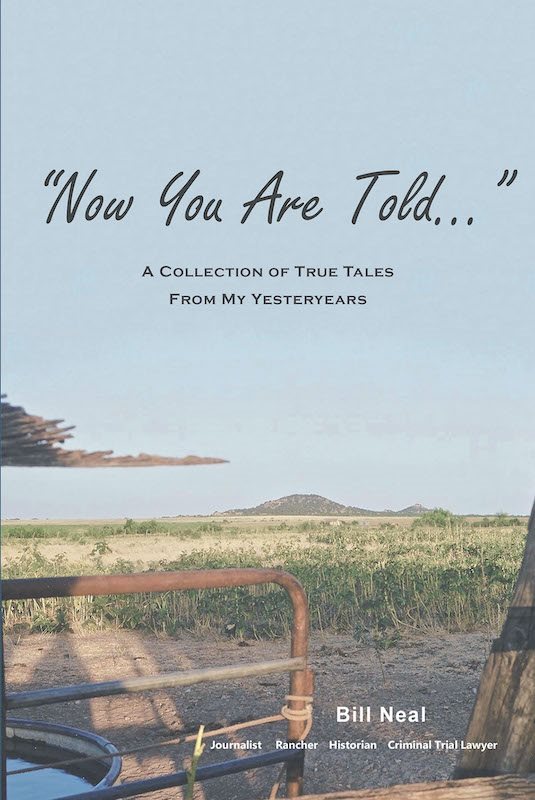Flavor of the Times (The Way It Was)
The Way It Was
B efore we begin our story, let me quote you some interesting episodes and newspaper clippings of that day and time to set the stage.
Ranchers vs. the Prairie Dogs
When Granddad Neal acquired the Medicine Mound Ranch in 1897 there was a prairie dog town located on it covering about ten acres. The prairie dogs caused two problems: they ate the grass down to the ground, and they made holes with openings slightly larger than a horses hoof. If a horse ran across a prairie dog town and stuck his foot in a hole, it would often break his leg. And there was nothing a rancher could do to rehabilitate the horse. Then the rancher would be required to put down the horse.
Therefore, ranchers had a vested interest in eradicating prairie dog towns, and that wasnt easy to do. More than forty years later, in the 1940s, Granddad Neal was still struggling with the problem of how to eradicate the prairie dogs. How he did it I dont recall, but he finally succeeded.
*****
Rabbit Drives
( Quanah Tribune-Chief, July 20, 1916)
The people at Medicine Mound united with a number of town men last Friday for a big rabbit drive that netted over eight hundred jackrabbits. The rabbits were shipped to Chicago and netted the hunters ten cents apiece which added to the five-cent bounty for the scalp. That made rabbit hunting pay at least.
About four scores of men and boys took part in the drive, which began from Will Neals ranch gate early in the morning. The drive started northeast, and went through pastures, and fields of row crops, all thickly infested with jackrabbits. The little animals have lately been coming in by the thousands from the brakes in the south, and are very poor, and have worked great havoc in the cotton patches. One man told us that he had lost twenty acres of cotton by the jackrabbits ravages.
Even though thousands of rabbits had been killed in that section of the county during the past week, their numbers did not seem to have decreased perceptibly.
Several ladies in buggies laden with provisions showed up at a Hackberry tree on the Moseley Farm for the noon dinner and the way those hungry men sailed into the many good things spread out under that tree was a caution.
Every man reported how many jackrabbits he had killed, and it was found that nearly four hundred had been slaughtered that morning.
Want of ammunition prevented the slaughter from going much over eight hundred. As it was, the drive was a great benefit for the farmers in that neighborhood, while the town men present all felt that they had real sport that day and enjoyed every minute of it.
*****
Rabbit Drive
( Quanah Tribune-Chief, January 19, 1918)
Be sure to come to the rabbit drive next week. Everybody should be at his station at 11:30. Everyone is asked to bring a good club along with him as in most drives there has been a shortage of clubs.
*****
Rabbit Scalps for Bounty
( Quanah Tribune-Chief, March 9, 1918)
J. H. Hodges brought in 1,016 rabbit scalps and M. O. Fields brought 341 to town for bounty. Several others brought in smaller amounts and swelled the number far past 1500.
*****
Thrift Stamps
( Quanah Tribune-Chief, February 2, 1918)
Friday night of this week, prizes of Thrift Stamps aggregating $10.00 will be given to pupils of Big Valley, Old Mounds, Clark, Mount Olive, and Star Valley, for the best essay on Thrift. The contest will be held at the Medicine Mound School. [During World War I, the US government turned to thrift stamps as one means of financing the war effort while instilling traditional values.]
*****
Crow Blasts
( Quanah Tribune-Chief, May 7, 1937)
Two miles northeast of Hackberry [community] was the scene of a crow blast Thursday night under the direction of Austin Aulds of the State Game Department.
Fifteen bombs, each carrying fourteen pounds of machine shop slugs and three sticks of dynamite, were touched off at 10:00 p.m. The bombs were constructed by means of stovepipes extending up into the trees, with the slugs and dynamite placed in the pipes. Each bomb was connected by wires to one switch controlled by a tractor, making it possible for all to be set off at the same time. Approximately one thousand crows were exterminated.
About one hundred spectators witnessed the blasting of these crows.
During the past winter crow blasts ridded nearby Wheeler County of some 200,000 crows in their desperate effort to rid that county of swarms of these pests.
Three years ago, the crows began to drift into Wheeler County, where only a few of the birds had been seen before. Farmers stood guard over their stack lots and took shots at them with shotguns, but still the black clouds swarmed over fields and feed stacks, destroying thousands of dollars of crops.
The roosts of the crows are located during the day while they are feasting on the fields and dynamite bombs are placed in the trees around the roosting place. Then when the birds have settled down for the night, the dynamite is discharged, sending thousands of the pests to their doom.
*****
Roping Jackrabbits
One of Granddad Neals ranching neighbors was named Jack Vantine. Like other ranchers he was pretty handy with a lariat rope and could rope and catch a runaway steer. But one time he outdid himself. It was on a Saturday afternoon when Jack and several of the men and boys of the Medicine Mound community were pitching dollars and pitching horseshoes or just lollygagging. Jack was playing with his lariat rope when a dog chasing a jackrabbit came right down Main Street of Medicine Mound. He tossed out his rope and caught that jackrabbit as it came by. Of course, that was just like making a hole-in-one in golfjust plain luckbut it made him look like a world champion roper.
Chapter 1
Medicine Mound: The Frontier Town That ThrivedThen Almost Died (The Night Mrs. Tidmore Torched the Town)
The Night Mrs. Tidmore Torched the Town
T he ranch where I grew up was named Medicine Mound Ranch because the largest of four mounds located on the ranch was called Medicine Mound. The mound rose 1,750 feet above the level prairie surrounding it. It acquired that name because the Comanche and Kiowa Indians who had occupied that part of the frontier thought that sick members of their tribes who bathed in a spring at the foot of the mound, ate certain medicinal herbs that grew there, and then slept on top of the mound would be cured of their ailments.
It was about the turn of the twentieth century when American pioneersmostly farmers and ranchersbegan settling on small plots of land in this area. As time went by, a small community they named Medicine Mound began to spring up about three miles east of those four mounds. However, the community really began to grow in 1908, when the Kansas City, Mexico and Orient Railroad began laying down tracks in that area. It became a thriving community with a number of businesses, including a bank, churches, a cotton gin, grain elevators, and a school. But the thriving community was not to last. A great tragedy happened shortly before I was born that would change Medicine Mound forever. Now draw up a chair, sit down, and let me begin telling you my tale.
One of the prominent families of Medicine Mound was the Jim Tidmore family, and if ever there was a story of a whole family who went to hell in a hand basket, as the old-timers used to describe a destiny of doom on the fast track, it had to be the story of the star-crossed Jim Tidmore family.
For quite a time, everything seemed almost perfect for them. They had it allpremiere social prominence, apparent wealth, a father who was a church deacon, and they were all healthy, popular, intelligent, and physically attractive. It seemed that the sky was the limit.



